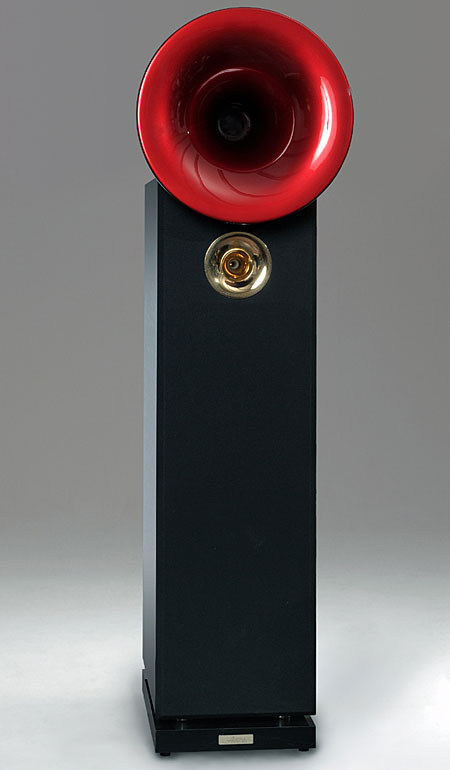Anyway, this speaker has some very interesting properties that causes it to behave in a way that you would not expect. The first sign that something strange is amiss can be seen with this measurement, comparing a nearfield MMM with a MLP SPS:
You can see that the nearfield MMM has a much sharper treble fall-off than at MLP. This is the opposite of what one would expect. To study the phenomenon, I did MMM's at various distances from the speaker:
What I expect to see from this measurement is something like this (this is a simulation, not a real measurement). All the frequencies should start dropping in loudness at an equal rate as we move further from the speaker.
Instead, we get this:
Notice how everything > 1kHz is bunched together. At 250cm, there is a 10dB drop in the woofer. But with the horns and tweeters, there is only a 2dB drop! This causes the frequency response to
tilt upwards the further away you get from the speaker - the horns/tweeter remain the same volume, but the subs and woofers drop in volume as expected. Toole says speakers are supposed to tilt downwards the further away you go. Erin provides a great explanation in
this video.
So what is causing my speaker to behave in the opposite way to a normal speaker? Obviously the horns have something to do with it, which is clear from the above graph where I indicated the crossover points. Anything not horn = normal expected behaviour. Anything horn = bunched together with minimal drop in volume.
My understanding of how horns work is rather basic, perhaps
@Duke might like to chime in. But it does seem to spray sound like a thumb over a garden hose. No thumb, and the stream of water spreads out and falls earlier (i.e. behaviour of the subs and woofers). Place the thumb on the outlet, and you get a concentrated jet of water that is narrow and travels further. Are the horns causing the sound to concentrate and behave like a "jet"?
I needed to explore the phenomenon more closely. Using the technique I described in
this thread I repeated a set of MMM's around the speaker.
Result:
You can see already the difference in directivity between the woofer and the horns. With an omni, you expect the volume to remain the same as you rotate around the speaker taking measurements. With anything that is directional, the volume drops quickly. Look at the difference between the red (0 degrees) and brown (45 degrees) curves. Almost a 10dB drop moving 45deg off axis. What is interesting is that at 90deg and 180deg (i.e. behind the speaker) the response of the horns is almost the same.
I then processed the raw measurements in REW using arithmetic functions.
@joentell helped me process the measurements into a contour plot:
And a polar plot:
Now obviously these are very rough and low resolution measurements, a bit like viewing a blurry photograph that has gone through the wash a few times. But even with blurry photographs, shapes can be discerned. I wouldn't read too much into each individual peak and dip, given the limitations of the measurement technique. But we can observe broad trends. This measurement is good enough for me to see:
- that the directivity indeed does narrow above 700Hz. The previous measurement showed a much sharper change in directivity. This made me redo the crossover between the woofer and midrange horn. Rather than the sharp steep filter I was using, I used Acourate's UBPol 11 filter, 0.5 order. This blended the woofer with the horn more gradually, and you can indeed see that the change in directivity is not so sudden.
- Notice the notch in the polar response at 4.5kHz. This is the crossover point between the midrange horn and tweeters.
- Notice how the directivity dramatically narrows from 13kHz up (more obvious in the polar plot). The tweeter is starting to beam. Why does it beam? I measured the tweeter diameter. The lower limit is: lambda = 2* diameter of horn. The diameter is 12cm, so wavelength 24cm, so 1.4kHz. The upper limit is 3 octaves above this, so 11.2kHz. At progressively shorter wavelengths above 11.2kHz, sound seems to exit the tweeter like a compressed jet of water. It does not lose much energy as it makes its way to MLP.
Amazing that we can see all this with this crappy measurement, eh!! I go to bed at night dreaming that I have won the lottery and I can go buy a Klippel. And then go into competition with Amir and make scathing Youtube videos

But until that happens, I make do with the tools that I have.
CONCLUSION
This speaker behaves the reverse of a normal speaker - it produces an upward tilting slope further away, rather than a downward tilt. The reason it behaves this way is because of the mixed driver types - conventional cabinets which radiate sound like a normal speaker, and horns above 500Hz. Measurements seem to indicate that it concentrates sound energy.
THEREFORE ... any attempt to correct the speaker to be "flat" anechoically
will result in an upward tilt at the listening position. This is why I don't do it.


